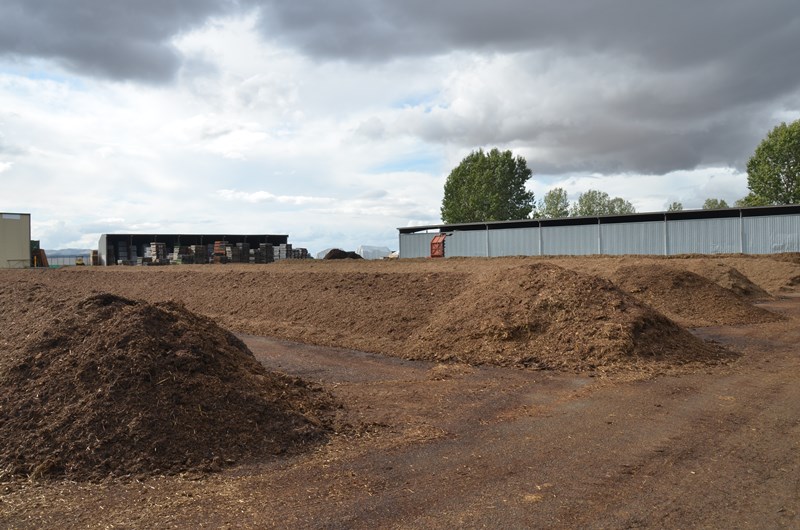Compost Bedding Saves the Day
A switch from newspaper to compost bedding changed everything
Eight years ago, Louie Kazemier was struggling with mastitis—forcing him to cull a lot of cows. New females were being bought in to keep up with the culls. Somatic cell counts (SCC) were running above 400,000 cell per mL. Kazemier was desperately searching for the cause—from milking protocols, housing to bedding.
|
| More on Rickreall Dairy |
“It was bad, and we were going broke,” Kazemier says of his Rickreall Dairy outside Rickreall, Ore.
Then, Kazemier made a trip down Interstate 5 to Junction City, Ore., looking to buy more replacement heifers from a friend’s dairy who also housed cows in a similar freestall setup. The only difference was the bedding type.
Rickreall Dairy was bedding on recycled newspaper at the time, which Kazemier now credits for his mastitis headaches. The friend was bedding on compost and only had one cow out of 600 milking in the hospital.
Kazemier came back to his dairy in disbelief at how well the compost bedding was working. He made another trip to the dairy in Junction City, this time with his herd manager so both of them could get a better feel for how bedding on compost worked.
After a few hours, they were sold, and the next week Rickreall Dairy purchased a compost turner.
“We’ve been growing ever since, and that was the last time I bought any animals,” he says.
The manure compost piles are placed into windrows just west of the dairy barns. Windrows are turned at least four times with a mobile turner to help dry out the solids.
At some points in the year, the compost can get up to 7" of moisture on it. During the summer, it runs at a moisture level of 45% to 50%; in the winter, it can be as high as 80%. To help dry it out, grass screenings are added from a nearby grass seed growing and cleaning operation.
One worker’s priority is to make and replace the compost bedding.
Hospital pens that were once at capacity with mastitis and lameness, now hold less than 0.2% of the herd. SCCs have been cut in half—measuring below 200,000 cells per mL. Cows are paying back the investment by producing 84 lb. of milk per day.
“It is nothing to sneeze at, but cow comfort took us a while to get there,” Kazemier says.

Stalls had to be redone three times, either widening or deepening, before they reached an optimal size for cow comfort.
Manure sludge is a byproduct of the fine bedding going through the separators. It has gone from a nuisance to a nice bartering chip.
Fifteen years ago, Kazemier was paying local farmers and grass seed growers to get rid of his manure, cost ing him $200,000 to $300,000 per year.
“Now it’s an income, but it took us a long time to develop it,” he says.
Today, Rickreall Dairy irrigates with the manure water on a majority of the 1,100 acres of farmland. Some nitrogen comes from the liquid portion, but the solids are high in phosphorus. That high phosphorus poses a problem for Kazemier because his fields have a heavy soil structure, leading to above-average phosphorus levels. Fortunately, the surrounding grass seed growers like the high phosphorus sludge.
“They’ve found when they harvest the grass seed around the first of July, if they come back with this sludge, the next year they’ll get almost a third more seed,” Kazemier says.
A dredge is used three months out of the year to clean the lagoons of the manure sludge at the bottom. Dozens of 900 gal. tanker loads of sludge will leave per day during those three months. It is then traded to grass seed growers in exchange for grass silage and hay.
In one recent trade, Kazemier was able to get an estimated $85,000 worth of clover silage. At the end of the year, the parties reconcile what the differences were in manure value versus forage.

A mobile turner attached to a tractor’s three-point hitch mixes the compost as it dries in the open air. Each windrow is turned at least four times. The compost will dry for four to six weeks before becoming bedding.
Taking in extra fruit waste has been another added profit center. Nine tons of fruit liquid waste is dumped into the manure separator each day. A nice benefit of the fruit waste is a reduction in lagoon odor.
Changes in how manure is managed at Rickreall Dairy has helped farm be more sustainable and efficient. It’s important factor for Kazemier because the farm employs 24 people and he is looking towards the third generation with his son Nate actively involved in the care of the dairy’s 1,700 milking cows.
The average employee has been with him for 18 years and turnover has been at a minimum. “The dairy is kind of in autopilot now,” Kazemier adds.


 Bonus Content
Bonus Content




